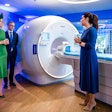CHICAGO - A new 32-slice CT scanner, a short-bore MRI magnet, and a flat-panel digital x-ray unit top the list of new RSNA product introductions for Toshiba America Medical Systems of Tustin, CA.
In CT, Toshiba has extended its Aquilion platform by introducing a 32-slice version, doubling the slice count found on Aquilion 16, previously the most advanced Toshiba CT scanner. Aquilion 32 employs a 64-row detector that collects 64 0.5-mm slices with each gantry rotation. Data can be reconstructed in either 32 x 1-mm or 32 x 0.5-mm modes, according to Doug Ryan, director of Toshiba's CT business unit.
Aquilion 32 retains the isotropic resolution found on other Aquilion models, which Toshiba has used to differentiate the Aquilion line from other multislice scanners. The first Aquilion 32 has been installed at Fujita University in Japan, with the first U.S. installation to take place in January at Johns Hopkins University in Baltimore. The scanner has 510(k) clearance and will sell at a list price about 50%-60% higher than Aquilion 16, Ryan said.
In other CT news, Toshiba is launching a family of CT applications with the "Sure" prefix. The Sure family incorporates some older Toshiba applications as well as new functionality demonstrated as works in progress. Among the works-in-progress applications are SureDiffusionEQ, which creates color maps of the brain for perfusion studies of early stroke detection, and SurePulmo for lung nodule detection. SureSubtraction supports image subtraction of pre- and post-contrast studies for CT digital subtraction angiography (DSA), while SurePlaque is designed for soft plaque identification and measurement.
Toshiba's new MRI scanner is Excelart Vantage, first displayed as a work-in-progress at last year's RSNA show. The system is the first Toshiba MRI scanner designed specifically for the U.S. market, and the first Vantage unit has been installed at Radiology, Ltd. in Tucson, AZ, according to Dane Peshe, director of Toshiba's MRI business.
Vantage was designed to minimize patient claustrophobia, featuring a magnet that is 1.4 m long with a 65.5-cm aperture. The scanner also includes Pianissimo, Toshiba's noise-reduction technology, and Speeder parallel-processing technique. Vantage features a more elegant integration of Pianissimo into the gantry design than does Toshiba's earlier 1.5-tesla offering, which extended the length of the bore to 1.6 m. With the new system, Pianissimo does not add any length to the scanner's bore, Peshe said.
Other Vantage specifications include a magnet homogeneity of 2 ppm over a 50 cm diameter spheric volume (DSV). The scanner is offered in two gradient options -- an amplitude of 30 mT/m and slew rate of 50 T/m/s, or an amplitude of 30 mT/m and a slew rate of 130 T/m/s. Powering the scanner are dual Intel Xeon processors that enable an image reconstruction rate of 400 images/second.
In the open-magnet segment, Toshiba has chosen to boost the gradient performance of its Opart 0.35-tesla platform rather than develop a new magnet with a higher field strength. The upgraded scanner, dubbed Ultra, features gradients with a 25 mT/m amplitude and 100 T/m/s slew rate. The older version of Opart has gradients rated at 10 mT/m amplitude and 20 T/m/s slew rate.
The Ultra gradient upgrade results in a scanner that scans faster has smaller fields of view, and that also supports high-field applications like single-shot echo-planar imaging (SSEPI) diffusion and 2-D and 3-D water-fat separation, according to Anita Bowler, product manager for open systems.
In x-ray, Toshiba is showing its T.Rad Plus radiography system with DR capabilities. The system is equipped with one or two DR panels and offers fast image preview, as well as a 17 x 17-inch field of view. It can be initially configured either as a DR or traditional x-ray system, allowing users the option to upgrade to digital technology.
Efficiency Plus is a new version of the Tosrad, an all-digital R/F system with table tilt of 90/45, 80-kW generator, 1-megapixel CCD imaging, multitasking digital processor, DICOM worklist management, and choice of image intensifier sizes: 12-inch, 14-inch, and 16-inch. It also has a works-in-progress flat-panel detector upgrade available.
On the Infinix VC-i angiography system, Toshiba has released a new digital 3-D angiography protocol, 3D-DA, that combines the anatomic resolution of digital subtraction angiography (DSA) with 3-D technology to improve visualization of bony structures during neurovascular exams. Toshiba believes 3D-DA can address the traditional drawbacks of DSA in providing information on the bony landmarks surrounding vessels, thus improving surgical planning or interventional procedures.
In ultrasound, Toshiba is featuring its new iAssist wireless remote control device, which allows remote user interface with the company’s Aplio premium ultrasound platform, first introduced last year.
The iAssist device uses Bluetooth wireless remote technology, allowing the operator to apply the transducer in hard-to-access places while keeping their attention focused on the screen. It is programmable, and communication with the platform is possible from anywhere in the exam room. Toshiba expects a Food and Drug Administration 510(k) clearance of iAssist by the first of next year.
Aplio offers real-time observation of arterial and portal phases, simultaneous display of vascularization and perfusion, and directional flow display. The platform captures microvasculature detail in the liver, kidney, breast, thyroid, lymph nodes, and other important structures. The version 5 upgrade for Aplio also has trapezoid imaging for both phased and linear transducers.
In nuclear medicine, Toshiba is highlighting a new version 3.0 of its e.soft workstation software, which functions with the company's t.cam Signature Series gamma camera (manufactured for Toshiba by Siemens Medical Solutions). The new software enables users to load more slices into a study, and to manage and display two image series with different matrix sizes, according to Martha Bonino, product manager for nuclear medicine.
Flash 3-D is a new iterative reconstruction package for SPECT that improves tumor detection, while other e.soft 3.0 advances include CT attenuation correction and advanced image fusion capabilities. e.soft Express enables remote viewing on a tablet PC, according to Bonino.
By Brian Casey
and Robert Bruce
AuntMinnie.com staff writers
December 2, 2003
Copyright © 2003 AuntMinnie.com



















